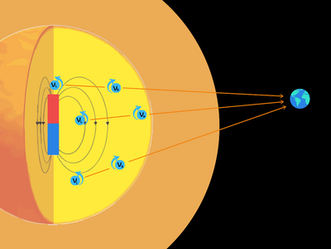In 1930, Wolfgang Pauli postulated the existence of a particle that was unknown at the time in order to solve an existing problem in the description of radioactive nuclear reactions: In the so-called Beta Decay of atomic nuclei, the fundamental laws of the conservation of energy and angular momentum are violated, unless another, almost massless and extremely difficult to detect particle is added to the equation - the so-called neutrino. In 1956, researchers achieved the first experimental detection of neutrinos. Today, three different types of neutrinos, named flavours, are known, that can transform into each other through so-called neutrino oscillations. The three types of neutrino all have extremely small but slightly different masses, where only the upper bound is known today.
Another fundamental property of neutrinos is a magnetic moment, which is associated with the mass of the particle. This was first mentioned by Pauli in his famous 1930s letter "Liebe Radioaktive Damen und Herren", but has not been proven experimentally to this date. The magnitude of this magnetic moment however influences the behaviour of a neutrino within an external magnetic field significantly and could shed light on many of the unanswered questions about neutrino mass.
Sudip Jana from the Max-Planck-Institut für Kernphysik in Heidelberg (MPIK) and Yago Porto from the "Gleb Wataghin" Institute of Physics at the University of Campinas in São Paulo, Brazil, have now for the first time considered the influence a twisting magnetic field within supernova explosions could have on the detection of neutrinos: while previous theories only considered neutrinos in fixed-direction magnetic fields, the researchers have now been able to show that neutrinos that are exposed to twisting magnetic field directions along their way out of the core of a supernova explosion, are subject to so-called resonant spin conversions. This results in a transformation of the specific neutrinos into quantum states that are for example associated with their respective anti-particle.
Since these transformations only take place at a very limited time in the first few milliseconds of the core collapse of the supernova, this effect can lead to a time-varying measurement of the neutrino and antineutrino flux from the supernova on Earth, in which the composition of the measured neutrino flux from the three neutrino types (flavours) also changes.
Future experiments currently under construction, such as the Deep Underground Neutrino Experiment, the Jiangmen Underground Neutrino Observatory or the Hyper-Kamiokande experiment, could therefore allow conclusions to be drawn about the properties of the long-sought magnetic moment of the neutrino by measuring a neutrino flux from supernova that fluctuates over time.
"When estimating the expected neutrino fluxes in these experiments an interaction of the magnetic moments with varying magnetic fields must be taken into consideration," notes Sudip Jana, one of the authors of the study and a post-doc at the MPIK. "This gives us a unique insight into the unanswered questions of neutrino physics and may lead to a better understanding of the necessary extension of the standard model of physics that researchers use today to explain the structure of our universe," he adds.
Original publication:
Resonances of supernova neutrinos in twisting magnetic fields
Sudip Jana and Yago Porto
Phyical Review Letters 132, 101005; DOI: 10.1103/PhysRevLett.132.101005
Link to division page: Particle and Astroparticle Physics
